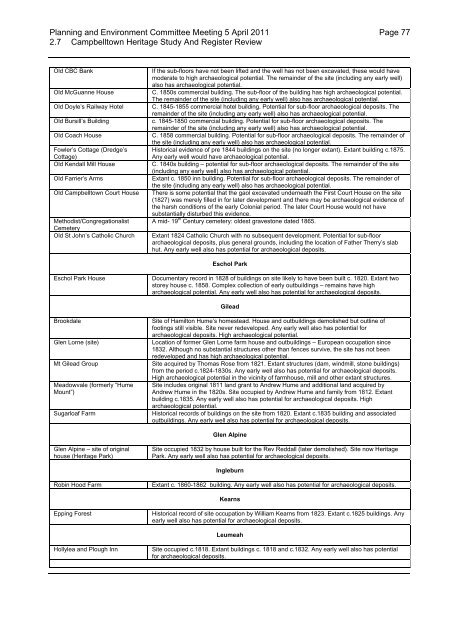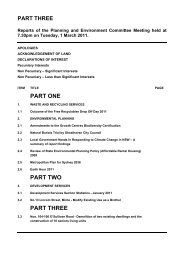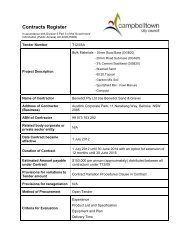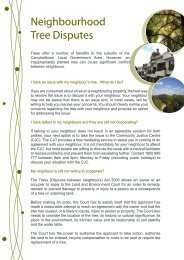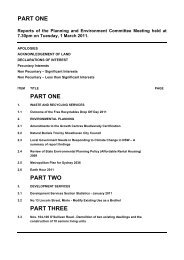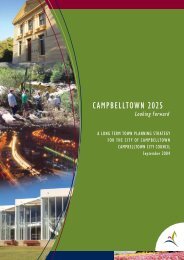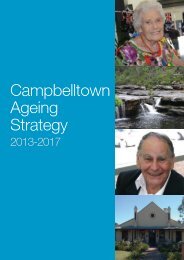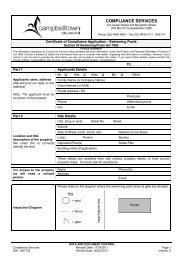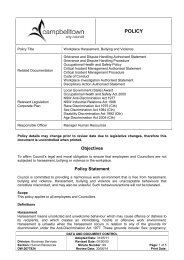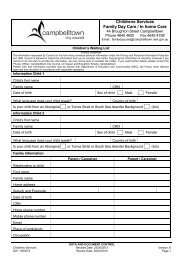PART ONE - Campbelltown City Council - NSW Government
PART ONE - Campbelltown City Council - NSW Government
PART ONE - Campbelltown City Council - NSW Government
You also want an ePaper? Increase the reach of your titles
YUMPU automatically turns print PDFs into web optimized ePapers that Google loves.
Planning and Environment Committee Meeting 5 April 2011 Page 772.7 <strong>Campbelltown</strong> Heritage Study And Register ReviewOld CBC BankOld McGuanne HouseOld Doyle’s Railway HotelOld Bursill’s BuildingOld Coach HouseFowler’s Cottage (Dredge’sCottage)Old Kendall Mill HouseOld Farrier’s ArmsOld <strong>Campbelltown</strong> Court HouseMethodist/CongregationalistCemeteryOld St John’s Catholic ChurchIf the sub-floors have not been lifted and the well has not been excavated, these would havemoderate to high archaeological potential. The remainder of the site (including any early well)also has archaeological potential.C. 1850s commercial building. The sub-floor of the building has high archaeological potential.The remainder of the site (including any early well) also has archaeological potential.C. 1845-1855 commercial hotel building. Potential for sub-floor archaeological deposits. Theremainder of the site (including any early well) also has archaeological potential.c. 1845-1850 commercial building. Potential for sub-floor archaeological deposits. Theremainder of the site (including any early well) also has archaeological potential.C. 1858 commercial building. Potential for sub-floor archaeological deposits. The remainder ofthe site (including any early well) also has archaeological potential.Historical evidence of pre 1844 buildings on the site (no longer extant). Extant building c.1875.Any early well would have archaeological potential.C. 1840s building – potential for sub-floor archaeological deposits. The remainder of the site(including any early well) also has archaeological potential.Extant c. 1850 inn building. Potential for sub-floor archaeological deposits. The remainder ofthe site (including any early well) also has archaeological potential.There is some potential that the gaol excavated underneath the First Court House on the site(1827) was merely filled in for later development and there may be archaeological evidence ofthe harsh conditions of the early Colonial period. The later Court House would not havesubstantially disturbed this evidence.A mid- 19 th Century cemetery: oldest gravestone dated 1865.Extant 1824 Catholic Church with no subsequent development. Potential for sub-floorarchaeological deposits, plus general grounds, including the location of Father Therry’s slabhut. Any early well also has potential for archaeological deposits.Eschol ParkEschol Park HouseDocumentary record in 1828 of buildings on site likely to have been built c. 1820. Extant twostorey house c. 1858. Complex collection of early outbuildings – remains have higharchaeological potential. Any early well also has potential for archaeological deposits.GileadBrookdaleGlen Lorne (site)Mt Gilead GroupMeadowvale (formerly “HumeMount”)Sugarloaf FarmSite of Hamilton Hume’s homestead. House and outbuildings demolished but outline offootings still visible. Site never redeveloped. Any early well also has potential forarchaeological deposits. High archaeological potential.Location of former Glen Lorne farm house and outbuildings – European occupation since1832. Although no substantial structures other than fences survive, the site has not beenredeveloped and has high archaeological potential.Site acquired by Thomas Rose from 1821. Extant structures (dam, windmill, stone buildings)from the period c.1824-1830s. Any early well also has potential for archaeological deposits.High archaeological potential in the vicinity of farmhouse, mill and other extant structures.Site includes original 1811 land grant to Andrew Hume and additional land acquired byAndrew Hume in the 1820s. Site occupied by Andrew Hume and family from 1812. Extantbuilding c.1835. Any early well also has potential for archaeological deposits. Higharchaeological potential.Historical records of buildings on the site from 1820. Extant c.1835 building and associatedoutbuildings. Any early well also has potential for archaeological deposits.Glen AlpineGlen Alpine – site of originalhouse (Heritage Park)Site occupied 1832 by house built for the Rev Reddall (later demolished). Site now HeritagePark. Any early well also has potential for archaeological deposits.IngleburnRobin Hood FarmExtant c. 1860-1862 building. Any early well also has potential for archaeological deposits.KearnsEpping ForestHistorical record of site occupation by William Kearns from 1823. Extant c.1825 buildings. Anyearly well also has potential for archaeological deposits.LeumeahHollylea and Plough InnSite occupied c.1818. Extant buildings c. 1818 and c.1832. Any early well also has potentialfor archaeological deposits.


